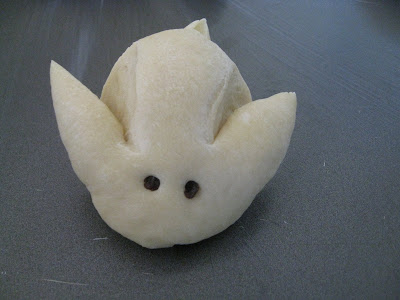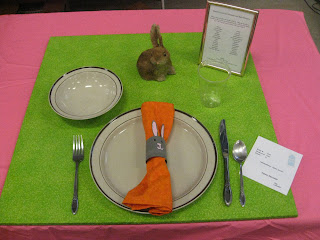Most people know that you can enter crafts, baked goods, photography, and homegrown vegetables in the county fair, but the fair is so much more than that. For example, did you know that there is an entire division for tablesettings? The concept is simple- you dream up an occasion and a menu, then create a placesetting and centerpiece around your theme. The results are beautiful, elaborate and so creative.
This was the first year that Trevor was eligible to enter a tablesetting in the fair in the 5-8 year old category (based on age on Jan 1). Step one was thinking up a theme. I helped him by brainstorming what his dream occasion would be. A themed birthday party? A big campout? A super fun Halloween meal with gross-out foods? No. Trevor wanted a huge outdoor party for bunnies and their owners, where all the food would be tasty and safe for both the bunnies and the people.
In all my years of looking at fair tablesettings, I've seen tons of birthdays, weddings, graduations, campouts, and picnics, but I've never seen a tablesetting based on food that pets and their owners would both enjoy. If that didn't earn full points for creativity, I don't know what would!
With the theme and menu in place, I took Trevor to the fabric store. He was hoping to find a bunny print, but they don't stock a lot of bunny prints 10 months before Easter. So instead, he chose a leaf-print green and carrot orange.

The plan was that the green would be the tablecloth and the orange would be the napkin. I taught Trevor how to use the sewing machine so that he could finish the edges of the orange fabric.

He put the finished napkin into the
bunny napkin ring that he made back in April. Adorable!
The next step was to write the menu. Trevor's idea was to list all the foods in two separate columns. The first would be foods that were healthy for the bunnies (kale, swiss chard, broccoli, etc) and the second would be foods that are treats for the bunny (peaches, bananas, strawberries, etc). I helped him type it out. The two columns were very unbalanced, so I showed him how we could balance the columns and use an asterisk to show which foods were treats. He liked that idea. Here's how the finished menu looked.
Finally, we got out the plate, bunny dish, cup, and silverware to go with our menu. His centerpiece was the rabbit he picked at the
San Francisco Flower Mart. Trevor practiced and practiced until he knew exactly where each item should go to set the perfect table.
On the big day, each child was assigned a location, then set-up time began. We were able to watch, but we couldn't coach or talk with our children as they worked.
I prepped Trevor ahead of time by saying that there would be lots of kids entering and that most of them would be older and more experienced than him. They would all have lots of good ideas. But Trevor was convinced he would be the winner. How could anything be better than a party for bunnies and their owners?!
There were a handful of no-shows. In the end, there were 11 entries. As predicted, all were really cute and well-done. Only one had a visible error (silverware in the wrong place).

Here's Trevor watching the judge look at his entry. She took a long time carefully reading his menu and checking his placesetting.
Then, one by one, the names were called for the children to get their participation ribbons. Seven names went by and Trevor's wasn't called. Could he possibly have placed?! Trevor's was the next name. Honorable mention. Not 1st, 2nd or 3rd, but a very fine showing for his first time and considering he was the youngest there.
He was disappointed not to have won the huge blue ribbon, but was very proud of his ribbon and how well he did.

After the contest, we were allowed to enter the area and look carefully at all the entries. Here is Trevor proudly reading his menu to his cousin Timothy.
I can't wait to see what he dreams up for next year!
























































